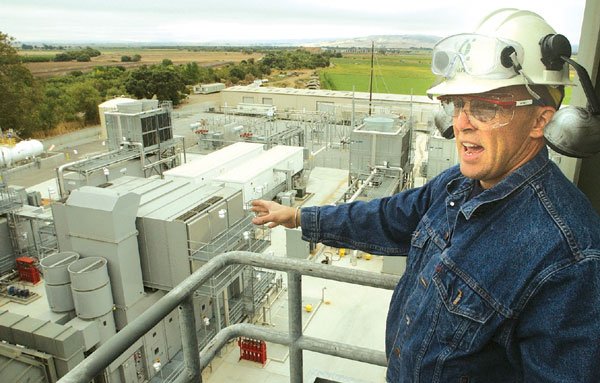Three peaker plants are on-line and at work to prevent
blackouts
GILROY – With the summer months straining California’s energy supply, Gilroyans can feel a little safer turning on the air conditioning knowing the city has an energy safety net designed to avoid major blackouts.
Energy supply became a concern last week when a power outage struck major cities in the Eastern United States and Canada.
Gilroy Energy Center, located next to the Gilroy Power Plant on Pacheco Pass Highway, consists of three “peaker” plants. They operate during times of peak energy use, such as hot summer afternoons when air conditioners are running in millions of homes across the state, helping to prevent rolling blackouts like those experienced in the summer of 2001.
“You get a surge of demand and these units can go from standstill to complete output in a matter of minutes,” said Kent Robertson, manager of public relations for Calpine Corp., the international energy company that operates the Gilroy plants. “You’re able to fill a void quickly and avoid power outages.”
In addition to the main power plant’s 135 megawatt capability, each peaker can produce 45 megawatts of energy – or roughly the amount of energy needed to service 1,000 homes. Normally, only one peaker is needed at a time to meet an increased energy demand.
The peakers react to fluctuations on the power grid. If demand rises quickly, Calpine is notified and the peakers spring into action.
To keep the necessary amount of energy flowing to California homes, various organizations – such as California Independent System Operator (ISO) – watch the grid all day, every day. A power forecast is created each day and electricity scheduled for delivery. The ISO takes a snapshot of grid activity every four seconds.
“The key to the grid is keeping it stable,” Robertson said. “Electricity is the only utility that is used the instant it’s created. You can’t really store it, so you’ve got to have a balance between what’s needed and what’s available.”
That is where the Gilroy peakers come into play. For example, say the grid needs a minimum of 100 units of power to keep bringing energy to homes and businesses. If demand increases to 150 units – overtaxing power plants – the peakers will add more power to where it’s needed on the grid. Energy will first flow to the point of highest demand, starting locally and moving farther away, Robertson said.
If increased demand is anticipated, the state Department of Water Resources will ask Calpine to use the peakers to provide a certain amount of energy for a specified period of time. Calpine entered into a contract with the state following the 2001 blackouts that allowed them to build the peakers. The contract established a price for each unit of energy supplied based on the price of natural gas.
If an increase in demand occurs unexpectedly, such as when a power plant experiences technical failure or a transmission line goes down, the ISO will immediately see the problem and alert Calpine that the peakers are needed. Calpine provides the energy for the ISO, which is distributed by PG&E.
The Gilroy peakers are automatically notified by a computer system when the energy supply is reduced because a power plant goes off-line, usually due to technical difficulties.
If peaker plants like Gilroy Energy Center were unavailable, the situation that caused the rolling blackouts would occur much more often. With too much demand and too little energy supply, the grid would collapse if some portions were not shut down.
If the power supply is 95 percent of the demand, 5 percent of the grid must be blacked out. The area that is blacked out is then rotated so everyone gets power at least some of the time.
The peakers would not be able to prevent the type of blackouts experienced across many eastern states last week because those were caused by transmission failure, Robertson said. Power lines and wires that carry energy completely shut down, so power plants were unable to put out any power.
“If you took what happened back East and apply it to California, California would have gone black, too,” Robertson said.
Gilroy’s three plants are part of the 15 Calpine now operates in Northern California, including four in San Jose. The peakers can only be installed in an area where there is a natural gas supply and a transmission line in close proximity, Robertson said.















